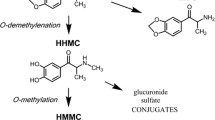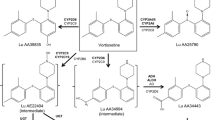Abstract
Background and Objectives
Bupropion is an atypical antidepressant and smoking cessation aid associated with wide intersubject variability. This study compared the formation kinetics of three phase I metabolites (hydroxybupropion, threohydrobupropion, and erythrohydrobupropion) in human, marmoset, rat, and mouse liver microsomes. The objective was to establish suitability and limitations for subsequent use of nonclinical species to model bupropion central nervous system (CNS) disposition in humans.
Methods
Hepatic microsomal incubations were conducted separately for the R- and S-bupropion enantiomers, and the formation of enantiomer-specific metabolites was determined using LC-MS/MS. Intrinsic formation clearance (CLint) of metabolites across the four species was determined from the formation rate versus substrate concentration relationship.
Results
The total clearance of S-bupropion was higher than that of R-bupropion in monkey and human liver microsomes. The contribution of hydroxybupropion to the total racemic bupropion clearance was 38%, 62%, 17%, and 96% in human, monkey, rat, and mouse, respectively. In the same species order, threohydrobupropion contributed 53%, 23%, 17%, and 3%, and erythrohydrobupropion contributed 9%, 14%, 66%, and 1.3%, respectively, to racemic bupropion clearance.
Conclusion
The results demonstrate that phase I metabolism in monkeys best approximates that observed in humans, and support the preferred use of this species to investigate possible pharmacokinetic factors that influence the CNS disposition of bupropion and contribute to its high intersubject variability.
Similar content being viewed by others
References
Fava M, et al. 15 years of clinical experience with bupropion HCL: from bupropion to bupropion SR to bupropion XL. Prim Care Compan J Clin Psychiatry. 2005;7(3):106–13.
Ornellas T, Chavez B. Naltrexone SR/bupropion SR (Contrave): a new approach to weight loss in obese adults. Pharm Therapeut. 2011;36(5):255–62.
Reimherr FW, et al. Bupropion SR in adults with ADHD: a short-term, placebo-controlled trial. Neuropsychiatr Dis Treatm. 2005;1(3):245–51.
Berigan TR. The many uses of bupropion and bupropion sustained release (SR) in adults. Prim Care Compan J Clin Psychiatry. 2002;4(1):30–2.
Hamedi M, et al. Bupropion in adults with attention-deficit/hyperactivity disorder: a randomized, double-blind study. Acta Medica Iranica. 2014:52(9):675–80.
Wilens TE, et al. An open trial of bupropion for the treatment of adults with attention-deficit/hyperactivity disorder and bipolar disorder. Biol Psychiatry 2003;54(1):9–16.
Woodcock J, Khan M, Yu LX. Withdrawal of generic budeprion for nonbioequivalence. N Engl J Med. 2012;367(26):2463–5.
Golden RN, et al. Bupropion in depression. II. The role of metabolites in clinical outcome. Arch Gen Psychiatry. 1988;45(2):145–9.
Connarn JN, et al. Identification of non-reported bupropion metabolites in human plasma. Biopharm Drug Dispos. 2016;37(9):550–60.
Hesse LM, et al. Pharmacogenetic determinants of interindividual variability in bupropion hydroxylation by cytochrome P450 2B6 in human liver microsomes. Pharmacogenet Genomics. 2004;14(4):225–38.
Laizure SC, et al. Pharmacokinetics of bupropion and its major basic metabolites in normal subjects after a single dose. Clin Pharmacol Ther. 1985;38(5):586–9.
Zhu AZX, et al. CYP2B6 and bupropion’s smoking-cessation pharmacology: the role of hydroxybupropion. Clin Pharmacol Ther. 2012;92(6):771–7.
Benowitz NL, et al. Influence of CYP2B6 genetic variants on plasma and urine concentrations of bupropion and metabolites at steady state. Pharmacogenet Genomics. 2013;23(3):135–41.
Zhu AZX, et al. Gene variants in CYP2C19 are associated with altered in vivo bupropion pharmacokinetics but not bupropion-assisted smoking cessation outcomes. Drug Metab Dispos. 2014;42(11):1971–7.
Connarn JN, et al. Pharmacokinetics and pharmacogenomics of bupropion in three different formulations with different release kinetics in healthy human volunteers. AAPS J. 2017;19(5):1513–22.
Grandas F, López-Manzanares L. Bupropion-induced parkinsonism. Mov Disord. 2007;22(12):1830–1.
Davidson J. Seizures and bupropion: a review. J Clin Psychopharmacol. 1990;10(1):60–2.
Johnston JALC, Ascher JA, et al. A 102-center prospective study of seizure in association with bupropion. J Clin Psychiatry. 1991;52:450–6.
Beyens M-N, et al. Serious adverse reactions of bupropion for smoking cessation: analysis of the French Pharmacovigilance Database from 2001 to 2004. Drug Saf. 2008;31(11):1017–26.
Gufford BT, et al. Stereoselective glucuronidation of bupropion metabolites in vitro and in vivo. Drug Metab Dispos. 2016;44(4):544–53.
Masters AR, et al. Chiral plasma pharmacokinetics and urinary excretion of bupropion and metabolites in healthy volunteers. J Pharmacol Exp Ther. 2016;358(2):230–8.
Kharasch ED, Mitchell D, Coles R. Stereoselective bupropion hydroxylation as an in vivo phenotypic probe for cytochrome P4502B6 (CYP2B6) activity. J Clin Pharmacol. 2008;48(4):464–74.
Coles R, Kharasch ED. Stereoselective metabolism of bupropion by cytochrome P4502B6 (CYP2B6) and human liver microsomes. Pharm Res. 2008;25(6):1405–11.
Suckow RF, et al. Pharmacokinetics of bupropion and metabolites in plasma and brain of rats, mice, and guinea pigs. Drug Metab Dispos. 1986;14(6):692–7.
Damaj MI, et al. Enantioselective effects of hydroxy metabolites of bupropion on behavior and on function of monoamine transporters and nicotinic receptors. Mol Pharmacol. 2004;66(3):675.
Damaj MI, et al. Effects of hydroxymetabolites of bupropion on nicotine dependence behavior in mice. J Pharmacol Experim Therapeut. 2010;334(3):1087–95.
Carroll FI, et al. Chapter 5: Bupropion and bupropion analogs as treatments for CNS disorders. In: Linda PD, editor. Advances in pharmacology. New York: Academic; 2014. p. 177–216.
Sager JE, Price LSL, Isoherranen N. Stereoselective metabolism of bupropion to OH-bupropion, threohydrobupropion, erythrohydrobupropion, and 4′-OH-bupropion in vitro. Drug Metab Dispos. 2016;44(10):1709–19.
Silverstone PH, et al. Convulsive liability of bupropion hydrochloride metabolites in Swiss albino mice. Ann Gen Psychiatry. 2008;7:19.
Skarydova L, et al. Deeper insight into the reducing biotransformation of bupropion in the human liver. Drug Metab Pharmacokinet. 2014;29(2):177–84.
Swan GE, et al. Dopamine receptor DRD2 genotype and smoking cessation outcome following treatment with bupropion SR. Pharmacogenomics J. 2004;5:21.
Spraggs CF, Dow D, Douglas C, McCarthy L, Manasco PK, Stubbins M, Roses AD. Pharmacogenetics and obesity: common gene variants influence weight loss response of the norepinephrine/dopamine transporter inhibitor GW320659 in obese subjects. Pharmacogenet Genomics. 2005;15(12):883–9.
Bondarev ML, et al. Behavioral and biochemical investigations of bupropion metabolites. Eur J Pharmacol. 2003;474(1):85–93.
Grabus SD, Carroll FI, Damaj MI. Bupropion and its main metabolite reverse nicotine chronic tolerance in the mouse. Nicotine Tob Res. 2012;14(11):1356–61.
Deveaugh-Geiss J, et al. GW320659 for the treatment of attention-deficit/hyperactivity disorder in children. J Am Acad Child Adolesc Psychiatry. 2002;41(8):914–20.
Volkow ND, et al. The slow and long-lasting blockade of dopamine transporters in human brain induced by the new antidepressant drug radafaxine predict poor reinforcing effects. Biol Psychiat. 2005;57(6):640–6.
Ascher JA, et al. Bupropion: a review of its mechanism of antidepressant activity. J Clin Psychiatry. 1995;56(9):395–401.
Schroeder DH. Metabolism and kinetics of bupropion. J Clin Psychiatry. 1983;44(5 Pt 2):79–81.
Martin P, et al. Antidepressant profile of bupropion and three metabolites in mice. Pharmacopsychiatry. 1990;23(04):187–94.
Agarwal V, et al. Drug metabolism in human brain: high levels of cytochrome P4503A43 in brain and metabolism of anti-anxiety drug alprazolam to its active metabolite. PLoS One. 2008;3(6):e2337.
Miksys S, Tyndale RF. The unique regulation of brain cytochrome P450 2 (CYP2) family enzymes by drugs and genetics. Drug Metab Rev. 2004;36(2):313–33.
Ravindranath V, Kommaddi RP, Pai HV. Unique cytochromes P450 in human brain: implication in disease pathogenesis. In: Riederer P, Reichmann H, Youdim MBH, Gerlach M, editors. Parkinson’s disease and related disorders. Vienna: Springer; 2006.
Khokhar JY, Tyndale RF. Drug metabolism within the brain changes drug response: selective manipulation of brain CYP2B alters propofol effects. Neuropsychopharmacology. 2011;36(3):692–700.
Ferguson CS, Tyndale RF. Cytochromes P450 in the brain: emerging evidence for biological significance. Trends Pharmacol Sci. 2011;32(12):708–14.
Sharon M, Tyndale RF. Brain drug-metabolizing cytochrome P450 enzymes are active in vivo, demonstrated by mechanism-based enzyme inhibition. Neuropsychopharmacology. 2009;34(3):634–40.
Toselli F, Dodd PR, Gillam EMJ. Emerging roles for brain drug-metabolizing cytochrome P450 enzymes in neuropsychiatric conditions and responses to drugs. Drug Metab Rev. 2016;48(3):379–404.
Khokhar JY, Miksys SL, Tyndale RF. Rat brain CYP2B induction by nicotine is persistent and does not involve nicotinic acetylcholine receptors. Brain Res. 2010;1348:1–9.
Cremers TIFH, et al. Development of a rat plasma and brain extracellular fluid pharmacokinetic model for bupropion and hydroxybupropion based on microdialysis sampling, and application to predict human brain concentrations. Drug Metab Dispos. 2016;44(5):624–33.
Welch RM, Lai AA, Schroeder DH. Pharmacological significance of the species differences in bupropion metabolism. Xenobiotica. 1987;17(3):287–98.
Meyer A, et al. Formation of threohydrobupropion from bupropion is dependent on 11β-hydroxysteroid dehydrogenase 1. Drug Metab Dispos. 2013;41(9):1671–8.
Hansard MJ, et al. A major metabolite of bupropion reverses motor deficits in 1-methyl-4-phenyl-1,2,3,6-tetrahydropyridine-treated common marmosets. Behav Pharmacol. 2011;22(3):269–74.
Kielbasa W, Kalvass JC, Stratford R. Microdialysis evaluation of atomoxetine brain penetration and central nervous system pharmacokinetics in rats. Drug Metab Dispos. 2009;37(1):137–42.
Kielbasa W, Stratford RE. Exploratory translational modeling approach in drug development to predict human brain pharmacokinetics and pharmacologically relevant clinical doses. Drug Metab Dispos. 2012;40(5):877–83.
Masters AR, et al. Stereoselective method to quantify bupropion and its three major metabolites, hydroxybupropion, erythro-dihydrobupropion, and threo-dihydrobupropion using HPLC-MS/MS. J Chromatogr B. 2016;1015–1016:201–8
Dunner DL, Billow AA, et al. A prospective safety surveillance study for bupropion sustained-release in the treatment of depression. J Clin Psychiatry. 1998;59:366–73.
Stahl SM, et al. A review of the neuropharmacology of bupropion, a dual norepinephrine and dopamine reuptake inhibitor. Prim Care Compan J Clin Psychiatry. 2004;6(4):159–66.
Connarn JN, et al. Metabolism of bupropion by carbonyl reductases in liver and intestine. Drug Metab Dispos. 2015;43(7):1019–27.
Bruijnzeel AW, Markou A. Characterization of the effects of bupropion on the reinforcing properties of nicotine and food in rats. Synapse. 2003;50(1):20–8.
Dalgaard L. Comparison of minipig, dog, monkey and human drug metabolism and disposition. J Pharmacol Toxicol Methods. 2015;74:80–92.
Wang X, et al. Metabolism of bupropion by baboon hepatic and placental microsomes. Biochem Pharmacol. 2011;82(3):295–303.
Schindler CW, et al. Comparison of the effects of methamphetamine, bupropion and methylphenidate on the self-administration of methamphetamine by rhesus monkeys. Exp Clin Psychopharmacol. 2011;19(1):1–10.
Banks ML, Smith DA, Blough BE. Methamphetamine-like discriminative stimulus effects of bupropion and its two hydroxy metabolites in male rhesus monkeys. Behav Pharmacol. 2016;27(2–3 Spec Iss):196–203.
Miksys S, et al. Smoking, alcoholism and genetic polymorphisms alter CYP2B6 levels in human brain. Neuropharmacology. 2003;45(1):122–32.
Avdeef A. Permeability: blood-brain barrier in absorption and drug development solubility, permeability, and charge state. Hoboken: Wiley; 2012. p. 595.
Acknowledgements
The authors thank Brandon Gufford (Indiana University), Jennifer Sager (Gilead Sciences), Andrea Masters (Indiana University), and Zeruesenay Desta (Indiana University) and Sara Quinney (Indiana University) for their technical advice.
Author information
Authors and Affiliations
Contributions
Participated in research design: CB, DK, RES, MVS. Conducted experiments: CB and DK. Performed data analysis: CB and DK. Wrote or contributed to the writing of the manuscript: CB, DK, RES, MVS.
Corresponding author
Ethics declarations
Funding
The studies reported in this publication were supported by a grant from the Charles Henry Leach II fund.
Conflict of interest
All the authors declare that they have no conflict of interest.
Electronic supplementary material
Below is the link to the electronic supplementary material.
Rights and permissions
About this article
Cite this article
Bhattacharya, C., Kirby, D., Van Stipdonk, M. et al. Comparison of In Vitro Stereoselective Metabolism of Bupropion in Human, Monkey, Rat, and Mouse Liver Microsomes. Eur J Drug Metab Pharmacokinet 44, 261–274 (2019). https://doi.org/10.1007/s13318-018-0516-4
Published:
Issue Date:
DOI: https://doi.org/10.1007/s13318-018-0516-4










